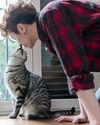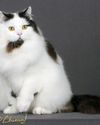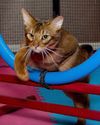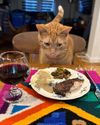Genetic Pleiotropy and the Risks in Breeding Recessive Mutations
April 2024
|Cat Talk
Nearly everyone loves what’s rare and unique. A slight defect in the minting process of a coin can create a demand and a value well beyond the face value of the coin. The coin is functionally no different than its perfectly minted counterpart, but its scarcity and uniqueness alone make it more desirable than the rest.

A Rare … Cat?
The cat fancy is no different. Many of our breeds are preserved or created based on a defect – the tailless Manx, the curly coated Rexes, the sparsely coated Lykoi, the naked Sphynx. People love Scottish Folds and American Curls for their uniquely folding ears, and American or Japanese Bobtails for their cute, poofy tails. Rare and flashy colors are popular, too. Lilacs, chocolates, cinnamon, goldens, bi-colors, and patched or calico males are very popular. Though we don’t like to think of these charming variants as defects, that’s what they are. Whether we call them variants, mutations, or defects, from a genetic point of view they are the same thing. Just like the rare coin created from a flaw in its minting process, genetic variants are created in much the same way – something goes awry in a cell’s duplication process, causing an error in the sequence of the nucleic acids that make up an organism’s DNA. Since genes come in pairs, nature has a backup system, and if one copy of an allele (one of two or more versions of a genetic sequence at a particular location on a chromosome) is defective, the other likely is not.
Time Will Tell …
هذه القصة من طبعة April 2024 من Cat Talk.
اشترك في Magzter GOLD للوصول إلى آلاف القصص المتميزة المنسقة، وأكثر من 9000 مجلة وصحيفة.
هل أنت مشترك بالفعل؟ تسجيل الدخول
المزيد من القصص من Cat Talk

Cat Talk
Holiday Aromatics
Are They Naughty or Nice?
3 mins
December 2024

Cat Talk
Feline Photographers Part 2
Social media is rife with pictures of our pets, especially cats.
11 mins
December 2024

Cat Talk
Celebrating the Season With Our Cats
As this writer began work on this project to find holiday stories involving cats, she was amazed to find that there are ELEVEN religious holidays celebrated during December!
4 mins
December 2024

Cat Talk
How Cats Find Their Owners
A month after losing her beloved senior cat, a woman named Amin Diane was parked on a street at night, waiting for her friend.
5 mins
December 2024

Cat Talk
Remembering Willa Hawke
Retired CFA Judge Emeritus Willa Hawke passed away August 2, 2024 in Lake Kiowa, TX at the age of 88. She had been a judge for over 50 years before her retirement in 2016.
1 mins
December 2024

Cat Talk
UP CLOSE AND Purr-sonal
Thoughtful... Caring ... Giving ...Helpful... Committed.
4 mins
December 2024

Cat Talk
DON'T PUFF AROUND PUFF!
THE EFFECT OF SECONDHAND SMOKE ON CATS
5 mins
December 2024

Cat Talk
Fluffy Coats
AND HOW TO CARE FOR THEM
7 mins
December 2024

Cat Talk
Feline Agility?
I Thought Agility Was For Dogs!
7 mins
December 2024

Cat Talk
Come Fly With Me!
TIPS ON NAVIGATING AIRPORT SECURITY WITH YOUR CAT
4 mins
December 2024
Listen
Translate
Change font size

